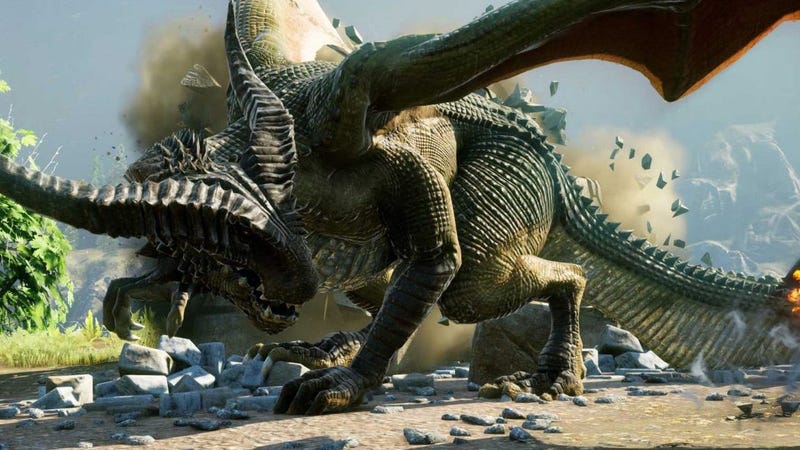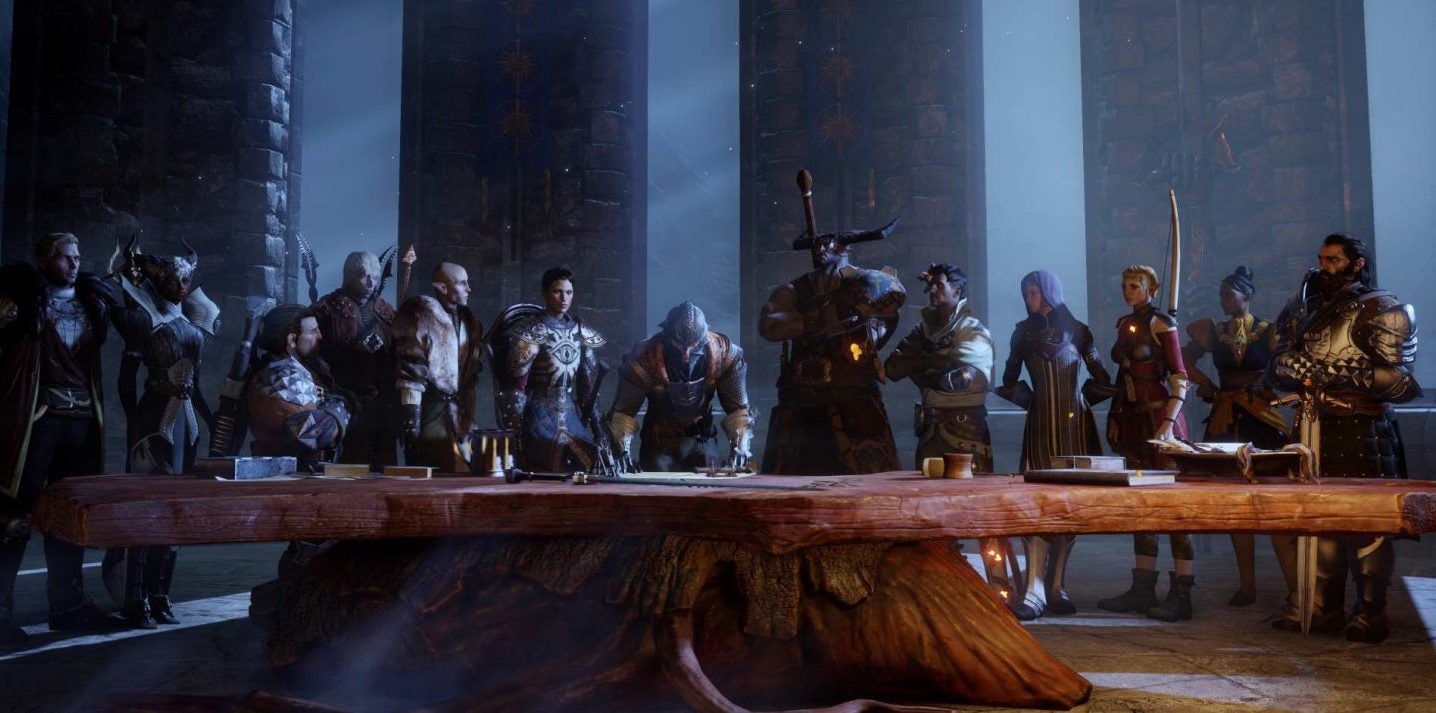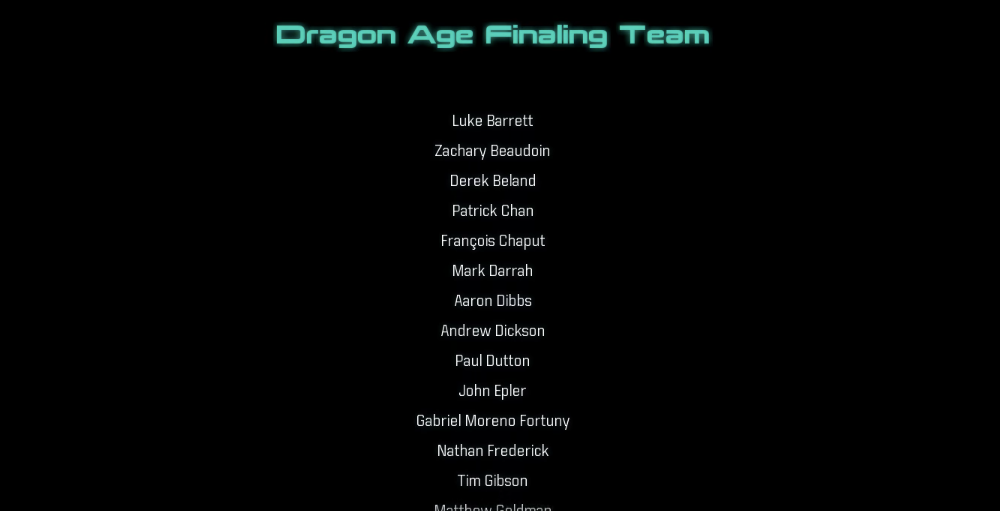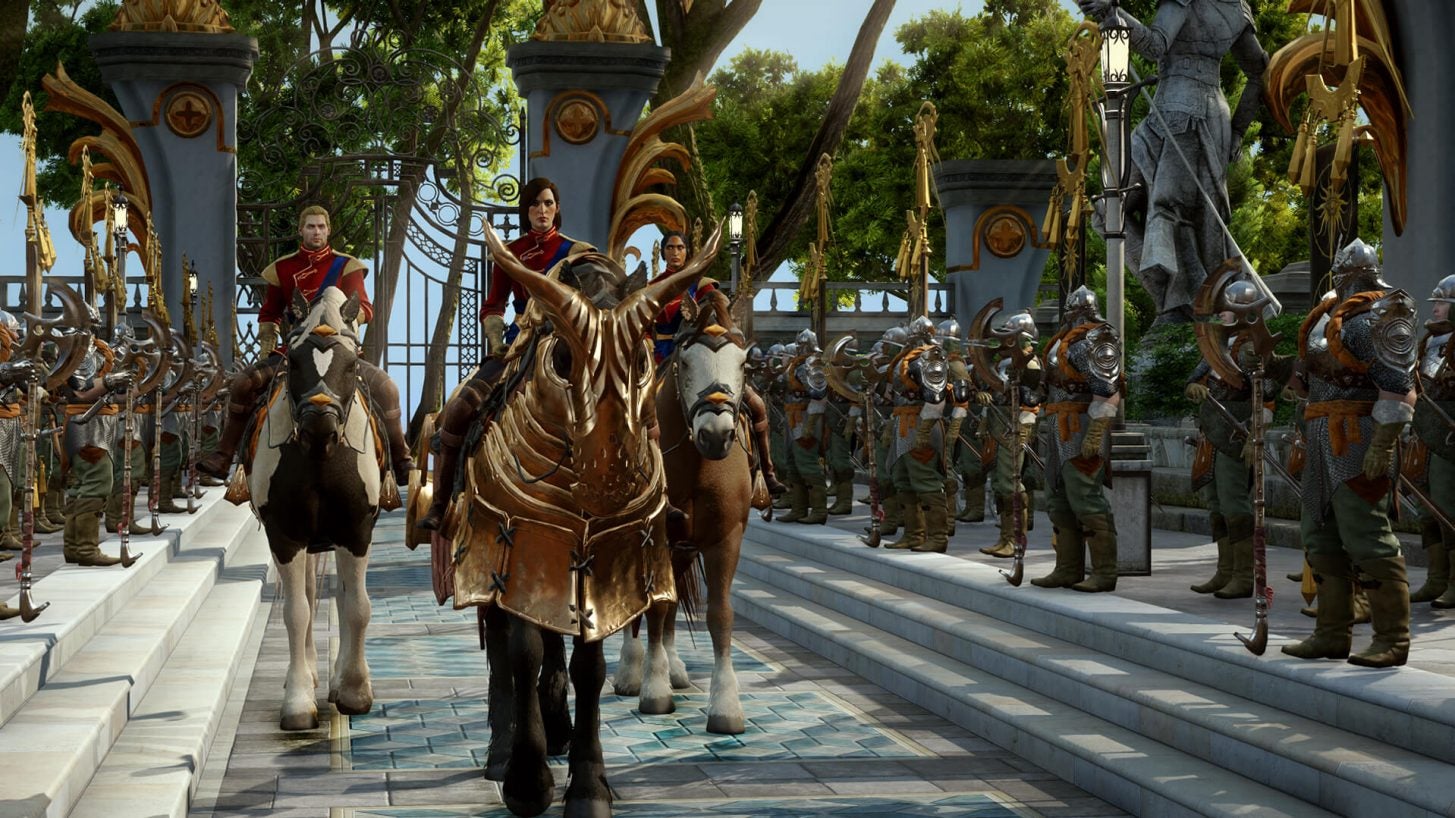The Past And Present Of Dragon Age 4
Screenshot: Dragon Age: Inquisition
In December 2018, developer BioWare
teased the next Dragon Age game, hinting at a mysterious future for the popular fantasy series—one that’s enticing, but seems very far away. Why, more than four years after
Dragon Age: Inquisition, is
Dragon Age 4 still so early in development? The answer is complicated, and reflective of BioWare’s turbulence over the past decade.
Last week, we published a lengthy investigation into how
Anthem, the new loot shooter from the beloved game studio,
went so awry. While reporting on this story and then in the days that followed, I learned a lot more about the current state of
Dragon Age, one of BioWare’s two tentpole franchises (alongside
Mass Effect, which was
put on ice in 2017 following the disappointing
Mass Effect: Andromeda but has since been warmed back up). I heard more about the first version of
Dragon Age 4, which was rebooted in October of 2017, and the current version, which is now in development at BioWare’s office in Edmonton, Alberta, Canada.
The story behind this reboot isn’t just a story of a game going through multiple iterations, as many games do. The
Dragon Age 4 overhaul was a sign of BioWare’s troubles, and how the company has struggled in recent years to work on multiple projects at the same time. It was indicative of the tension between EA’s financial goals and what BioWare fans love about the studio’s games. It led to the departure of several key staff including veteran
Dragon Age creative director Mike Laidlaw, and it led to today’s
Dragon Age 4, whose developers hope to carefully straddle the line between storytelling and the “live service” that EA has pushed so hard over the past few years. (EA did not return a request for comment.)
Perhaps the saddest thing about
Dragon Age 4’s cancellation in 2017 for members of the
Dragon Age team was that this time, they thought they were getting it right. This time, they had a set of established tools. They had a feasible scope. They had ideas that excited the whole team. And they had leaders who said they were committed to avoiding the mistakes they’d made on
Dragon Age: Inquisition.
But
Anthem was on fire, and BioWare needed everyone to grab a hose.
In the fall of 2014, BioWare released
Dragon Age: Inquisition, the studio’s first modern open-world game and the first role-playing game to be made on EA’s Frostbite engine. It was a critical success, selling well for BioWare’s standards and winning Game of the Year at the 2014 Game Awards. It was also a catastrophic production, by all accounts, one that was documented in the book
Blood, Sweat, and Pixels. (Full disclosure: I know the author of that book pretty well.)
The short version:
Dragon Age: Inquisition was hampered by a host of problems, including the challenges of shipping on five platforms at once (PC, PS4, PS3, Xbox One, and Xbox 360), the addition of a multiplayer mode to
Dragon Age for the first time, and the technical difficulties of Frostbite. Too many people were assigned to work on the game when it first started development, forcing the leadership team to spread themselves thin and make fast, questionable decisions in the interest of ensuring that everyone had work to do (work that they’d frequently have to redo later). Most notably,
Inquisition was the product of the “BioWare magic” documented in our
Anthem investigation. Much of the design and story was finalized during the final year of development, leading to stress and crunch throughout 2014 as the
Inquisition team scrambled to finish the game.
One of the biggest problems was that the chilly reception to
Dragon Age 2, a narrow, often repetitive game made in just 14 months, left the developers feeling skittish and insecure. As creative director Mike Laidlaw told me in an interview for the book a few years ago, this insecurity led him and his fellow directors to second-guess a lot of their decisions. “You’re following a negative experience,” he said. “You’re not quite sure where and how to get it back. And on top of that you’re introducing all this new gameplay that leads to an inherent insecurity.”
By the time
Inquisition finally launched in November of 2014, everyone was burnt out. Laidlaw and executive producer Mark Darrah told staff they would try to do things better for their next project, acknowledging that they had made mistakes and telling the staff they didn’t want to shoulder that kind of load again. They said they would focus on delivering an explicit, consistent vision and communicating that vision to the team in as efficient a manner as possible.
Following 2015’s critically acclaimed
Trespasser expansion, the
Dragon Age team split up. Many of the people who’d worked on
Inquisition moved to the troubled
Mass Effect: Andromeda, while a few dozen developers including Darrah and Laidlaw started spinning up the next
Dragon Age, which was code-named Joplin.
The plan for Joplin was exciting, say people who worked on it. First and foremost, they already had many tools and production pipelines in place after
Inquisition, ones that they hoped to improve and continue using for this new project. They committed to prototyping ideas early and often, testing as quickly as possible rather than waiting until everything was on fire, as they had done the last time thanks to the glut of people and Frostbite’s difficulties.
“Everyone in project leadership agreed that we couldn’t do that again, and worked to avoid the kind of things that had led to problems,” said one person who worked on the project, explaining that some of the big changes included: 1) laying down a clear vision as early as possible, 2) maintaining regular on-boarding documents and procedures so new team members could get up to speed fast; and 3) a decision-making mentality where “we acknowledged that making the second-best choice was far, far better than not deciding and letting ambiguity stick around while people waited for a decision.” (That person, like all of the sources for this story, spoke under condition of anonymity because they were not authorized to talk about their experiences.)
Another former BioWare developer who worked on Joplin called it “some of the best work experiences” they’d ever had. “We were working towards something very cool, a hugely reactive game, smaller in scope than
Dragon Age: Inquisition but much larger in player choice, followers, reactivity, and depth,” they said. “I’m sad that game will never get made.”
You’d play as a group of spies in Tevinter Imperium, a wizard-ruled country on the north end of
Dragon Age’s main continent, Thedas. The goal was to focus as much as possible on choice and consequence, with smaller areas and fewer fetch quests than
Dragon Age: Inquisition. (In other words, they wanted Joplin to be the opposite of
the Hinterlands.) There was an emphasis on “repeat play,” one developer said, noting that they wanted to make areas that changed over time and missions that branched in interesting ways based on your decisions, to the point where you could even get “non-standard game overs” if you followed certain paths.
A large chunk of Joplin would center on heists. The developers talked about building systemic narrative mechanics, allowing the player to perform actions like persuading or extorting guards without the writers having to hand-craft every scene. It was all very ambitious and very early, and would have no doubt changed drastically once Joplin entered production, but members of the team say they were thrilled about the possibilities.
The first big hiccup came in late 2016, when BioWare put Joplin on hold and moved the entire team onto the troubled
Mass Effect: Andromeda, which needed as many hands as possible during its final months of development. Those people, who worked on the game for three or four months, are noted in the game’s credits as the
Dragon Age “finaling team”:
Once
Andromeda shipped in March 2017, it was back to
Dragon Age for this team, even as some of them started to sense that
Anthem was going to be the next project to turn into an all-hands-on-deck disaster. The Joplin team expanded with people who were rolling off
Andromeda and kept working, prototyping, and designing the game. After spending months of their lives helping finish a
Mass Effect that didn’t excite a ton of people, it was nice to return to
Dragon Age.
One thing that wasn’t discussed much on Joplin was multiplayer, according to a few people who worked on the project, which is perhaps why the project couldn’t last. While BioWare’s publisher and parent company, Electronic Arts, tends to give its studios a fair amount of autonomy, there are still mandates to follow. By 2017, EA had not been secret about its desire to make all of its major products into “
games as a service,” best defined as games that can be played—and monetized—for months and years after their release. Traditional
Dragon Age games did not fit into that category.
Inquisition had a multiplayer mode, but was something like that really going to bring in the long-term revenue that EA wanted from expensive productions like
Dragon Age 4?
While reporting on
Anthem, I kept hearing one interesting sentiment from current and former BioWare staff: They felt like the weirdos in EA’s portfolio, the guys and gals who made nerdy role-playing games as opposed to explosive shooters and big sports franchises. BioWare games never sold quite as well as the
FIFAs and
Battlefields of the world, so it never felt like they could get quite as many resources as their colleagues at other studios. High-ranking BioWare staff openly wondered: Did EA’s executives really care about narrative? Did they really care about RPGs? Those questions have always lingered, and still do today.
By the latter half of 2017,
Anthem was in real trouble, and there was concern that it might never be finished unless the studio did something drastic. In October of 2017, not long after veteran
Mass Effect director Casey Hudson returned to the studio to take over as general manager, EA and BioWare took that drastic action, canceling Joplin and moving the bulk of its staff, including executive producer Mark Darrah, onto
Anthem.
A tiny team stuck around to work on a brand new
Dragon Age 4, code-named Morrison, that would be built on
Anthem’s tools and codebase. It’s the game being made now. Unlike Joplin, this new version of the fourth
Dragon Age is planned with a live service component, built for long-term gameplay and revenue. One promise from management, according to a developer, was that in EA’s balance sheet, they’d be starting from scratch and not burdened with the two years of money that Joplin had already spent. Question was, how many of those ideas and prototypes would they use?
It’s not clear how much of Joplin’s vision will shape Morrison (at least some of it will, says one person on the game), but shortly after the reboot, creative director Mike Laidlaw left, as did some other veteran
Dragon Age staff. Matt Goldman, art director on
Dragon Age: Inquisition and then Joplin, took over as creative director for Morrison, while Darrah remained executive producer on both that project and
Anthem.
In early 2018, when I first reported that BioWare had
rebooted the next Dragon Age and that its replacement would be a live service game, studio GM Casey Hudson responded on Twitter. “Reading lots of feedback regarding Dragon Age, and I think you’ll be relieved to see what the team is working on. Story & character focused. Too early to talk details, but when we talk about ‘live’ it just means designing a game for continued storytelling after the main story.”
At The Game Awards in December 2018, BioWare teased Morrison with a vague trailer, hinting at the return of the enigmatic villain Solas and promising in a blog post that
the team was full of vets. “We’ve gathered our strongest team yet and are venturing forth on the most epic quest ever,” wrote Goldman.
So what does all this mean, exactly? How much of a multiplayer focus will
Dragon Age 4 have? Is it online-only? We’re not sure about all the details, and in fact they’re likely still being decided, as the game is still very early in development and could evolve based on the negative reception to
Anthem. Rumor among BioWare circles for the past year has been that Morrison is “
Anthem with dragons”—a snarky label conveyed to me by several people—but a couple of current BioWare employees have waved me off that description. “The idea was that
Anthem would be the online game and that
Dragon Age and
Mass Effect, while they may experiment with online portions, that’s not what defines them as franchises,” said one. “I don’t think you’ll see us completely change those franchises.”
When asked, a few BioWare developers agreed that it’d be technically possible for a game built on
Anthem’s codebase to also have an offline branch, but it’s not yet clear whether Morrison will take that approach. If it does turn out to be an online game, which seems likely, it would be shocking if you couldn’t play the bulk of it by yourself. (
Diablo III, for example, is online-only on PC yet can be played entirely solo.) One person close to the game told me this week that Morrison’s critical path, or main story, would be designed for single-player and that goal of the multiplayer elements would be to keep people engaged so that they would actually stick with post-launch content. Single-player downloadable content like
Dragon Age: Inquisition’s
Trespasser, while often excellent, typically sells only a fraction of the main game, according to developers from BioWare and elsewhere across the industry.
Yet this wouldn’t be a “live service” game if it was a repeat of
Dragon Age: Inquisition, which compartmentalized its single- and multiplayer modes. Fans in the past have grown outraged at the idea of BioWare putting a lot of emphasis on multiplayer gaming, but there are ways in which a service-heavy
Dragon Age 4 could be ambitious and impressive. For example, some ideas I’ve heard floated for Morrison’s multiplayer include companions that can be controlled by multiple players via drop-in/drop-out co-op, similar to old-school BioWare RPGs like
Baldur’s Gate, and quests that could change based not just on one player’s decisions, but on the choices of players across the globe.
Screenshot: Dragon Age: Inquisition: Trespasser
Maybe in two or three years, Morrison will look completely different. It’s not like
Dragon Age hasn’t changed drastically in the past. In the office, BioWare developers often refer to Mark Darrah’s
Dragon Age team as a pirate ship, one that will eventually wind up at its destination, but not before meandering from port to port, drinking as much rum as possible along the way. His is a team that, in the past, has iterated and changed direction constantly—something that they hoped to cut down for Joplin, but has always been part of their DNA (and, it should be noted, heavy iteration is common in all game development). One BioWare employee summed it up well as we talked about the future of BioWare’s fantasy franchise. “Keep in mind,” they said, “
Dragon Age games shift more than other games.”
Said another current BioWare employee about Morrison: “They have a lot of unanswered questions. Plus I know it’s going to change like five times in the next two years.”
There are other questions remaining, too: With BioWare’s Austin office gradually taking over
Anthem going forward, when will the bulk of employees at the company’s Edmonton HQ move to the Morrison team? Will Morrison be able to avoid following the lead of
Dragon Age: Inquisition, which took on too many people too early and wound up suffering as a result?
And, most important, will BioWare work to prevent the burnout that has led to dozens of developers leaving over the past two years, with so many citing stress, depression, and anxiety?
Last week, just a few minutes after the publication of our
Anthem report, EA and BioWare put out a statement (written before they could have read the article) that was
disheartening to some current and former employees and felt almost dismissive of their issues. The next day, in an e-mail to employees, BioWare GM Casey Hudson sent
a far more assuring message, promising change “to make BioWare the best possible place to work.” But there have been several recent employee departures, with more (I hear) on the way, and wide-scale leadership improvements may take a long time.
The depression and anxiety that has been described by current and former BioWare employees didn’t just result from crunch. It came from people who felt stressed and exhausted, who felt like they couldn’t voice their opinions, who felt like their goal posts were constantly moving, who felt like they’d be targeted for speaking out. These were issues of management and leadership, not just scheduling. In order to protect the identities of employees who spoke to us for the
Anthem article, we weren’t able to share some of the saddest and more devastating anecdotes we heard during reporting, but they painted an ugly picture.
We’ve also heard questions and stories from other developers who faced the same sort of issues at other big video game studios, who noted that the idea of “BioWare magic” is common across the industry, not just specific to BioWare. We intend to continue tackling these questions and reporting on these stories.
We’ll have to see how the next few months and years proceed. If there’s one wish among people connected to BioWare (besides “get rid of Frostbite”), it’s that Morrison will follow Joplin’s lead and not just become a great game, but an example of a project whose leaders are trying to do production right.



























